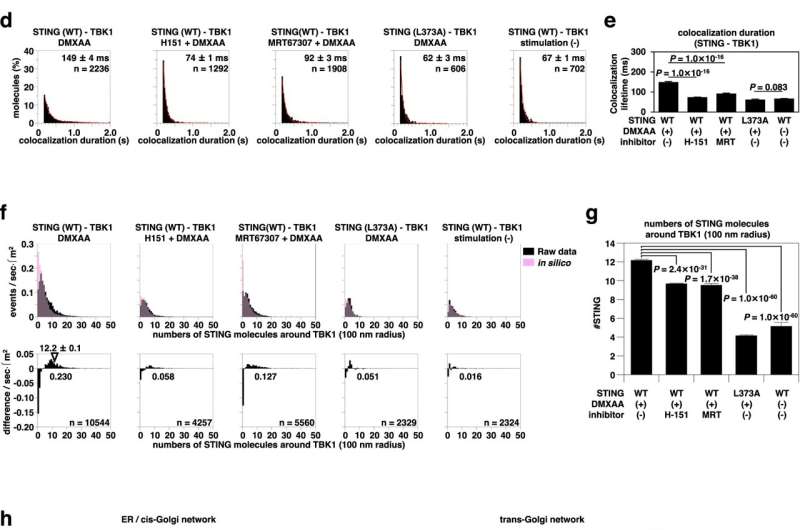This article has been reviewed according to Science X's editorial process and policies. Editors have highlighted the following attributes while ensuring the content's credibility:
fact-checked
peer-reviewed publication
proofread
Team explores role of 'stimulator of interferon genes' in body's innate immune system

When pathogens attack the body, the innate immune system goes to work protecting against the invading disease. The innate immune system is the first line of defense. It detects precisely what the virus or bacteria is and then activates the proteins that fight the pathogens. Wanting to better understand how the body's innate immune system works, a team of scientists undertook a study of STING, a protein that plays a vital role in innate immunity.
The team provides quantitative results, showing how STING, an acronym for stimulator of interferon genes, works in innate immune signaling.
Their work is published in the journal Nature Communications on Jan 11, 2024.
Type I interferons are signaling proteins that respond when they detect the presence of viruses. They play an essential role in the body's immune system, communicating between cells as they fight against pathogens.
STING is critical for the type I interferon response to pathogen- or self-derived DNA in the cytosol, the fluid portion of a cell. While STING plays an important role in the body's successful protection against infections, dysregulated STING activity leads to the excessive production of inflammatory mediators that can have a detrimental effect on surrounding cells and tissues.
Recent studies have made the connection between STING and a number of autoinflammatory and neurodegenerative diseases.
"STING was discovered as a protein that induces innate immune signals in response to virus-derived non-self DNA. The STING innate immune response has recently been reported to play an important role in cancer immune responses and to contribute to inflammatory pathologies in aging, autoinflammatory, and neurodegenerative diseases, making it a highly attractive target for disease therapy," said Kenichi G.N. Suzuki, a professor at the Institute for Glyco-core Research, Gifu University and a chief at the Division of Advanced Bioimaging, National Cancer Center Research Institute.
Research suggests that STING may function as a scaffold to activate the TANK-binding kinase 1 (TBK1). TBK1 is a signaling molecule that is activated by receptors when a viral infection occurs. Scaffold proteins do the important job of regulating key signaling pathways. However, up to this point, scientists have lacked direct cellular evidence proving that STING activated the TBK1.
To analyze the STING cluster, the research team used a live-cell imaging procedure called photoactivated localization microscopy or PALM. They performed this single-molecule imaging of STING with enhanced time resolutions down to 5 milliseconds. They determined that STING becomes clustered at the trans-Golgi network. The trans-Golgi network, or TGN, is a pathway in the body that directs proteins to the correct subcellular destination.
The team also proved that STING palmitoylation facilitated the STING clustering. Palmitoylation describes a protein modification process in the body. This palmitoylation of STING is required for the cluster formation of STING at the TGN. The Golgi lipid order, along with STING palmitoylation, is essential for the STING signaling. The team examined the role of cholesterol, a lipid that plays an essential role in generating the lipid order in STING's signaling and clustering.
They used a cholesterol biosensor and an environmentally sensitive probe for lipid membranes, to further demonstrate that cholesterol plays a role in the palmitoylated STING-formed clusters that activate TBK1 at the TGN.
The team specifically examined the formation of STING clusters as it relates to COPA syndrome. COPA syndrome is a disorder of immune dysregulation characterized by an increase in type I interferon-stimulated genes. This autoimmune disorder can impact multiple systems in the body.
The team's imaging of TBK1 revealed that the increase in the clustering enhances the association of TBK1. "We provide quantitative proof-of-principle for the signaling STING scaffold, reveal the mechanistic role of STING palmitoylation in the STING activation, and resolve the long-standing question of the requirement of STING translocation for triggering the innate immune signaling," said Tomohiko Taguchi, a professor in the Graduate School of Life Sciences, Tohoku University.
Looking ahead, the team sees potential for this work helping in the fight against disease. "In the present study, we showed that inhibition of cholesterol transport to TGN markedly suppressed the STING innate immune response. Therefore, based on the results of this study, it is expected that reducing cholesterol levels will be a new tool to treat the diseases associated with STING inflammation," said Suzuki.
More information: Haruka Kemmoku et al, Single-molecule localization microscopy reveals STING clustering at the trans-Golgi network through palmitoylation-dependent accumulation of cholesterol, Nature Communications (2024). DOI: 10.1038/s41467-023-44317-5


















